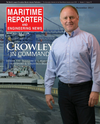
Page 109: of Maritime Reporter Magazine (November 2017)
The Workboat Edition
Read this page in Pdf, Flash or Html5 edition of November 2017 Maritime Reporter Magazine
uilt by New York Shipbuilding Corporation in March 2015 and Italian WWII destroyer Artigliere in in Camden, N.J., the 623-foot-long, 9,800- March 2017, as well as the recovery of the bell from the ton Portland Class heavy cruiser USS In- HMS Hood for presentation to the British Navy.
dianapolis (CA-35) entered service during Other search missions to locate Indianapolis have been peacetime in November 1932, later going undertaken by various groups over the years, but all have on to serve heroically through campaigns come up short – partly due to a lack of suf? cient technol-
B that earned the ship 10 battle stars over the course of World ogy. For the Indianapolis search, Mr. Allen deployed an ex-
War II. ploration team out? tted with the latest state-of-the-art deep
But after much success in battle, the fate of the Indianapo- search and exploration equipment aboard the newly acquired lis eventually turned tragic as World War II neared its end. In 76-meter-long DP2 vessel RV Petrel. Vulcan Inc. purchased the early hours of July 30, 1945, having just completed a se- the offshore service vessel in 2016 from subsea engineering, cret mission to deliver materials from California for the ? rst construction and services company Subsea 7. The ship was operational atomic bomb, “Little Boy” to a naval base on the converted into a bona? de deep submergence research vessel
Paci? c island Tinian, Indianapolis was en route from Guam in 2017, and now sails as one of the select few ships world- to Leyte when it was torpedoed by Japanese submarine I-58. wide equipped to explore 6,000 meters below the ocean’s
Indianapolis sank quickly – reportedly in just 12 minutes surface.
– leaving little time for the crew to deploy lifeboats or for For the Indianapolis search, the Vulcan team conducted a an emergency signal to be sent. It is estimated that 800 of signi? cant amount of research, leveraging a combination of the nearly 1,200 Sailors and Marines on board survived the historical records, detailed undersea topographical data and sinking, but a communication error prevented Navy com- advanced technology to explore a 400 square nautical mile mand from having any knowledge of the sinking, and rescu- search area between Guam and Palau in the Philippine Sea. A ers were not immediately dispatched. This left survivors to key data point came from a discovery by Dr. Richard Hulver, battle exposure, dehydration, drowning and shark attacks for a historian with the Naval History and Heritage Command, a grueling four to ? ve days at sea until help ? nally arrived. who identi? ed a naval landing craft that had recorded sight-
In the end, only 316 were rescued in what remains the largest ing the USS Indianapolis hours before it was torpedoed. All loss of life at sea in U.S. naval history. this research led to a new estimated position west of where
Due to the ship’s rapid sinking and lack of a distress call, previous searches have been conducted.
the ship’s location had long remained a mystery – until re- But even with the new insight, ? nding a ship that has been cently. missing for over seven decades is no easy task, especially at
Microsoft co-founder, philanthropist and entrepreneur depths greater than 5,000 meters. Aiding Vulcan’s team is a
Paul G. Allen is fascinated with World War II history. Com- 6,000-meter-rated autonomous underwater vehicle (AUV), bining this passion with a spirit of technological innovation, the REMUS 6000, manufactured by Kongsberg Maritime
Mr. Allen and his Seattle-based company Vulcan Inc. set out subsidiary Hydroid Inc., which gathered sonar data to locate to hunt for the Indianapolis. The team embarked with several the USS Indianapolis.
high-pro? le marine archaeology projects already under their Used regularly in commercial, research and defense ap- belt, including the discovery of Japanese battleship Musashi plications, the REMUS 6000 AUV has been labeled a www.marinelink.com 109
MR #11 (106-113).indd 109 MR #11 (106-113).indd 109 11/6/2017 4:13:45 PM11/6/2017 4:13:45 PM

 108
108

 110
110
